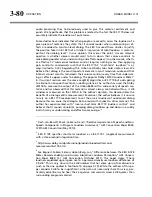
6-2
CONTROL API
ORBAN MODEL 1101
connected from a Local card. The default port can be changed here too.
Note that you only need to supply a password in the commands shown in Table 6-1
if you previously created a Terminal Password. See step (7.E) on page 2-7.) If there is
no password assigned to the card, omit the brackets [] shown in the examples.
To control OPTIMOD-PC externally, establish a Telnet/SSH connection and issue
commands and parameters, either by typing them directly into a Telnet/SSH client or
by placing them within batch files. Then process them with a scriptable Telnet/SSH
client that supports this operation, such as PuTTY, along with its companion com-
mand-line interpreter, Plink. Both of these applications are available for free
download. Search “PuTTY” with Google to find a download site.
Automating control changes is possible by using the Windows Task Scheduler to
launch batch files at the desired time.
Custom third party applications can be developed to use this protocol. Additionally,
you can include this protocol in an existing application by using small subsets of the
standards-based Telnet/SSH protocols directly, or for simplicity, by using scripting or
by calling batch files with a Telnet/SSH client such as PuTTY along with its compan-
ion command-line interpreter, Plink. Scripting eliminates the need to develop net-
working code or otherwise contend with complex, limited-function Microsoft Win-
dows specific programming APIs, like the Windows Audio Mixer. Developing a third
party application or including the protocol in an existing application eliminates hav-
ing to install and configure additional applications. Using small subsets of the stan-
dards-based Telnet/SSH protocol allows more operational flexibility without a system
performance hit and simplifies development compared to proprietary OEM APIs.
Commands are case-sensitive and must be entered exactly as shown. Replace
“[password]” with the actual password of the card being addressed. If there is no
password assigned to the card, omit the brackets [] shown in the examples.
Table 6-2 describes the available command strings and their functions. To demon-
strate this functionality, you may type the commands directly into a Telnet/SSH client
terminal and see OPTIMOD-PC confirmation and status messages.
Command Values
Function
D1OSR
32kHz 44.1kHz 48kHz 88.2kHz 96kHz
Digital 1 Output Sample Rate
D1OF
AES S/PDIF
Digital 1 Output Format
D2OSR
32kHz 44.1kHz 48kHz 88.2kHz 96kHz
Digital 2 Output Sample Rate
D2OF
AES S/PDIF
Digital 2 Output Format
DCR
Int D1 D2 CLK
Digital Clock Reference
A1IRL
+4dB –10dB
Analog 1 Input Ref Level
AGC1
Enabled Disabled
AGC 1 Enable/Disable
AGC10
EQ0 EQ1
AGC Output EQ Enable/Disable
A1PIL
–Inf, –40.0dB to 0.0dB
(in 0.1dB steps)
Analog 1 Process Mixer Input Level
D1PIL
–Inf, –40.0dB to 0.0dB
(in 0.1dB steps)
Digital 1 Process Mixer Input Level
Summary of Contents for Optimod-PC 1101
Page 4: ......
Page 14: ......
Page 121: ...OPTIMOD PC OPERATION 3 1 Section 3 Operation Figure 3 1 The OPTIMOD PC Control Application...
Page 192: ...3 72 OPERATION ORBAN MODEL 1101...
Page 204: ......
Page 210: ......
Page 212: ...5 2 UNINSTALLATION ORBAN MODEL 1101...
Page 236: ......
















































